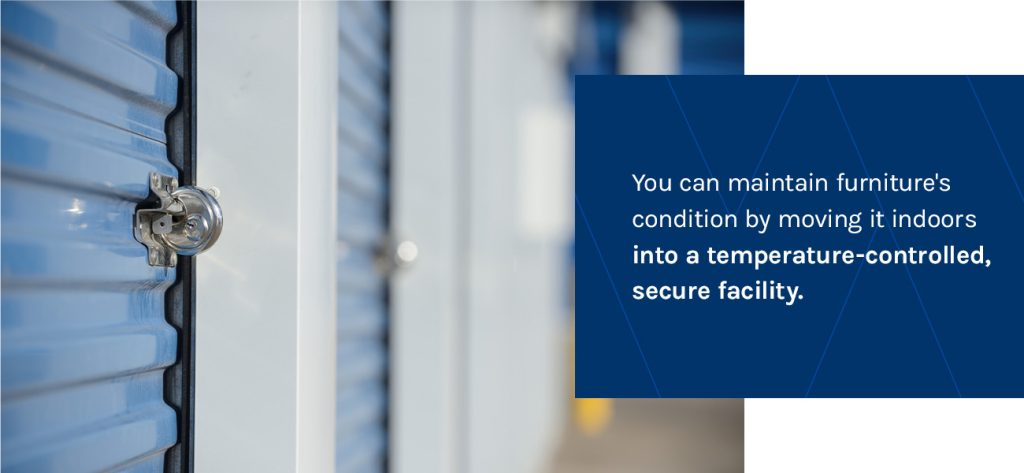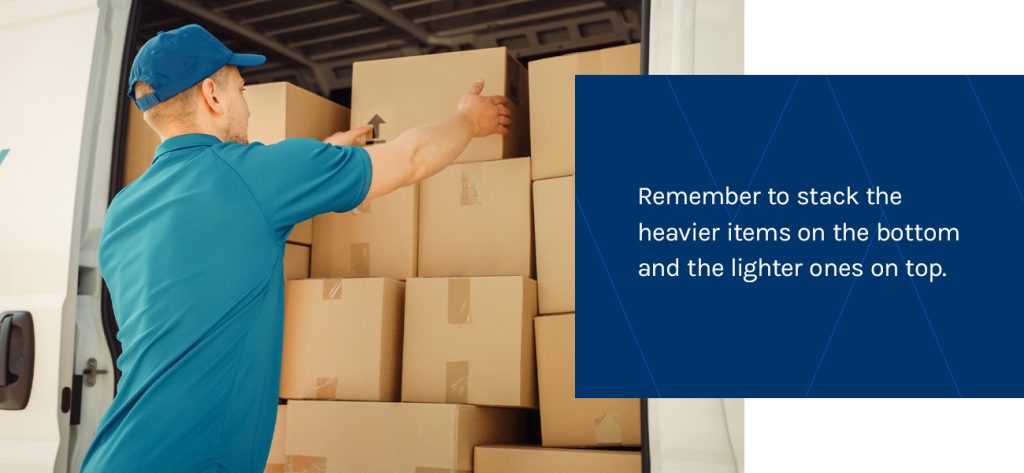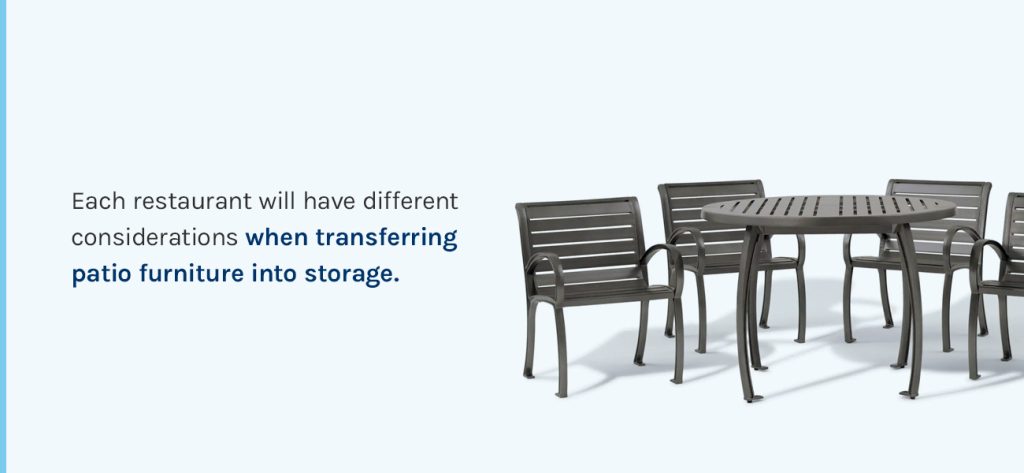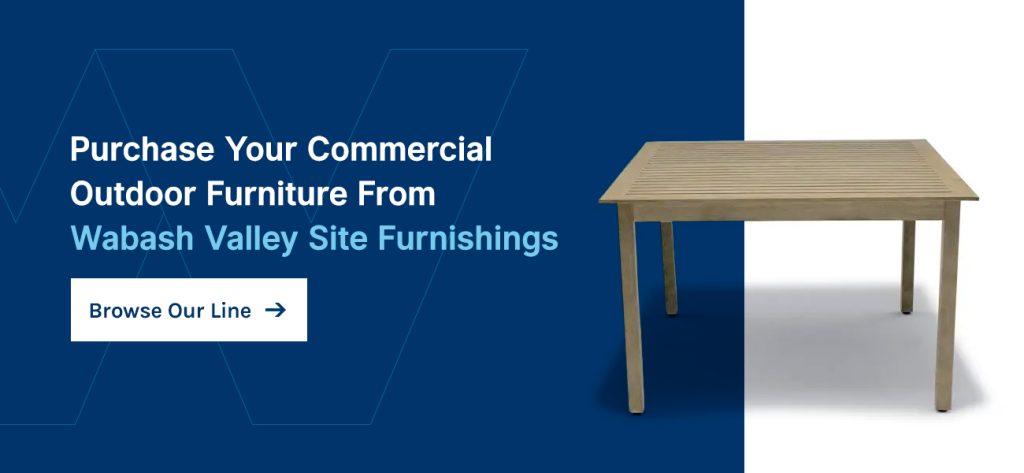How to Store Commercial Outdoor Furniture in Winter

Uncategorized | Dec 8, 2022
Your patio area provides guests with a refreshing atmosphere during the warmer months. Outdoor tables and chairs let customers enjoy eating al fresco on sunny days. But when winter returns, they seek the comfort and warmth of indoor dining settings. Remember to protect your outdoor furniture from inclement weather as you focus on indoor services.
Snow, ice and freezing temperatures can damage your outdoor furniture. To protect these pieces, you should place them in storage. Following the correct procedures as you prepare and place your furniture into storage spaces is essential.
Read on to learn more about commercial outdoor furniture storage. You can read the full article or skip to a specific section:
- The Importance of Properly Storing Commercial Outdoor Furniture
- How Do Outdoor Furniture Materials Hold up in the Winter?
- How to Prepare Commercial Furniture for Winter Storage
- How to Store Commercial Outdoor Furniture
- Storage Tips for Each Furniture Type
- Benefits of Keeping Commercial Outdoor Furniture in Storage
- Purchase Your Commercial Outdoor Furniture With Wabash Valley Site Furnishings
The importance of properly storing commercial outdoor furniture

The correct storage techniques can extend your furniture’s life span and protect it from harsh winter conditions. Your patio furniture adds an exciting outdoor option for guests, and you’ll want to carefully maintain these pieces. Establishing an outdoor dining area takes many steps, from selecting your new furniture pieces to arranging them in an engaging design. By taking the proper storage precautions, you can protect this investment of time and money.
Winter weather can harm commercial outdoor furniture, especially if you leave it outside for the whole season. Storage is an ideal solution for furniture protection. You can maintain furniture’s condition by moving it indoors into a temperature-controlled, secure facility. And once warmer months return, you can easily retrieve the pieces and put them back out on your restaurant’s patio.
By carefully following storage procedures, you can make your furniture last longer. You avoid costly replacements due to winter damage and can reuse your pieces each year. Best of all, customers will return to attractive, high-quality furniture in warmer months.
How do outdoor furniture materials hold up in the winter?

Your patio furniture might consist of various materials, which may respond differently to winter exposure. By taking a closer look at how each type lasts in the winter, you can further see the importance of winter storage.
Here’s an overview of common outdoor furniture types and how they withstand winter conditions.
- Wood: Wood is a popular choice for outdoor chairs and tables. You can find wood chairs in a wide range of styles and species. You can also paint over wood to create your ideal color scheme. While wood is durable and comfortable, it doesn’t respond well to moisture. Excess water can cause the wood to rot, eventually leading to structural collapse if not treated. In addition, protective coatings can start wearing away in freezing temperatures, causing wood to degrade. By placing your wooden furniture in storage, you can keep it away from moisture and frigid temperatures.
- Wicker: Wicker is a wood-based material, and another frequently chosen option for patio furniture. It’s comfortable and attractive for guests as they dine outside. However, wicker is a thin and sensitive material. Harsh winter conditions and temperatures can damage wicker-based furniture. Additionally, the wicker cannot handle moisture due to its wooden composition. Water can cause wood rot and mold to develop between the woven patterns. Moving your wicker pieces to a storage unit can prevent exposure to wintry atmospheres.
- PVC composite: Polyvinyl chloride is available in many styles, colors and sizes, making it an excellent choice for restaurants. However, cold temperatures also affect this plastic material. While PVC doesn’t rot like wooden furniture, winter weather still adversely affects it. Freezing conditions cause the plastic to harden and become brittle. The more fragile the material is, the easier it becomes to snap or break it. And, harsh outdoor temperatures can fade the colors and overall furniture condition. It’s better to keep your PVC furniture safe by placing it in storage.
- Iron: Many restaurants use iron materials for their outdoor furniture. Known for their durability, iron materials will last for many years and provide an attractive furniture component. However, iron is susceptible to winter damage just like other materials. Without protective coatings, iron will rust when exposed to the outdoors. Depending on their severity, brutal temperatures could slice through protective layers and cause rust. You should strive to keep your furniture as rust-free as possible to keep your customers safe. A secure storage facility can house iron and block exposure to outdoor elements.
- Fabric: Lastly, you might use fabric for various outdoor applications. Many designers add fabric cushions to chairs to provide more comfortable seating for guests. You can also use pillows or tablecloths as accents for your tables and chairs. With so many fabric types and colors available, you’re sure to find options that match your setup and color scheme. You should also shield fabric from outdoor winter environments. If the material experiences excess snow or ice, it could lose its softness or cushion. In addition, constant exposure to cold temperatures could fade colors in tablecloths or other similar items. To prevent this degradation, you should store your fabric furniture and materials indoors.
Overall, most materials will degrade when faced with severe winter weather. Instead of sacrificing your investment, place them in a storage facility for peace of mind.
How to prepare commercial outdoor furniture for winter storage

Once you’ve decided to use storage for the winter months, it’s time to prepare for the upcoming transition. These are some actions to take before you start moving pieces.
- Clean each piece: The first step you should take is to clean your outdoor furniture. Residual dirt, water and other debris can cause mold or rot to form while the pieces are in storage. Before you move each piece to a storage unit, clean it thoroughly. Proper cleaning methods vary by materials. For instance, cleaning chemicals that work well with PVC might ruin wooden furniture. It’s best to follow your manufacturer’s instructions for the proper cleaning techniques, and make sure to dry everything completely before putting it into storage.
- Apply protective coatings: Adding a protective layer to your furniture creates another line of defense against outdoor elements. You can use various waxes, oils and sprays to coat your furniture before moving it into storage. Refer to your manufacturer’s instructions to find the best protective coating for each material type.
- Prepare your storage space: You should also select and prepare a storage area for your furniture. Use a dry and secure area to keep the pieces safe. Many choose a storage shed, basement or garage. Once you’ve picked a space, make enough room for everything. Some owners stack pieces on top of one another to maximize space. After you’ve arranged them, consider throwing a tarp over them to keep out dust, bugs or other disturbances.
how to store Commercial outdoor furniture
After preparing your furniture, it’s time to take the next steps for storage. Here are steps you can follow to move your commercial outdoor furniture into storage successfully.
1. Evaluate Which Pieces to Move

First, it helps to take stock of what types and how many pieces of furniture you own. While you can easily move some pieces into storage, others might be more challenging. For instance, transporting lightweight plastic chairs will probably be simpler than carrying a heavy metal table. You can leave heavier pieces outdoors and secure them with tarps and straps. By making a plan for each furniture piece, you can make your moving process more efficient.
Start by inventorying each piece. Then, decide which ones you plan to move and which you will secure outside. For example, you might move all your chairs and accessories into storage but leave tables outdoors.
2. Disassemble Each Piece
Once you’ve selected items for storage, you can dismantle them. As mentioned in the preparations section, you should clean the pieces before disassembling them. Breaking your furniture into smaller parts makes transporting and storing it easier. And if your furniture contains any fragile components, such as glass, disassembling can protect them further.
These are some steps you can refer to during dismantling.
- Determine what to leave intact: You don’t have to take apart every piece of furniture for storage. Some options might not come apart easily, or others might not break down at all. For instance, some plastic chairs come in one solid piece. You can leave larger pieces like benches, tables or oversized chairs in one piece if you prefer.
- Carefully take apart each item: Use care as you disassemble each piece. For chairs, you can remove the legs first. Remember to keep each furniture group together, and don’t mix different components. It helps to keep each piece in a separate pile during this process.
- Keep screws and small parts: As you take apart each piece, keep track of screws and additional connecting parts. Collect these into a bag and label which furniture piece they belong to.
3. Pack Your Furniture

After you’ve dismantled the desired pieces, you can pack them into moving boxes. Your storage facility is likely a distance away from your outdoor eating area, so moving boxes can help you safely transport your furniture.
You can use materials like packing paper to secure each piece. Bubble wrap adds an additional layer of protection during transit. Then, you can place them into the appropriately sized moving boxes.
Here are a few other furniture packing tips.
- Use blankets as covers: You can cover dismantled pieces with blankets. These soft materials provide extra coverage during the transition into storage. Blankets can also block dust and other debris while the furniture rests in storage. Use tape to secure the blankets in place and ensure they don’t fall off during movement.
- Label everything: Once you fill a box, label it as specifically as possible. You can take note of the furniture type or what dismantled materials are inside. These notes make it much easier to unpack your furniture later. Instead of unpacking boxes randomly and discovering what’s inside, you can move purposefully.
- Separate lightweight and heavy items: Keep lightweight and heavy items separated as you place furniture into boxes. Heavier furniture can damage more delicate pieces. For example, wicker furniture is lighter and more sensitive than most metal pieces. If you place both materials into one box, the metal items could crush or harm the wicker. To keep everything safe, pack similar materials together.
4. Move Them Into Storage

Next, it’s time to move the boxes and furniture into your selected storage area. You can ask for help from employees or hire moving professionals. If your storage location is nearby, such as in a basement, you could carefully transport the boxes on foot. But if you’re using a storage facility in a separate area, you should use trucks or vans to move the furniture boxes.
Once you have the boxes in your desired location, you can arrange them in the best configuration for you. You can organize free-standing furniture to fit your pattern as well. For instance, you might have left plastic chairs in one piece rather than dismantled them. You could stack those chairs next to your boxes.
Remember to stack the heavier items on the bottom and the lighter ones on top. You can cover the boxes and furniture with tarps, blankets and other protective coverings.
5. Secure Other Pieces
Lastly, you can address any pieces that you left outdoors. You might have been unable to transport heavy tables, chairs or other outdoor components. Fortunately, you can still protect these pieces while they rest outside. As you do so, follow these steps.
- Moving it toward a wall: Even if you don’t have storage space, you can still move furniture to areas that offer more of a shield against wintry conditions. For instance, you could place tables and chairs against a wall or under a roof awning. These building features can offer a little more protection against snow and wind. For example, an awning would catch some snowfall and protect tables and chairs from feeling the full impact.
- Using tarps: Tarps are an essential protective measure if you need to leave some furniture outdoors. These thick coverings can shield your furniture from snow accumulation and add a barrier to freezing temperatures. Cover each furniture piece completely with the protective covering. Make sure you don’t leave any parts exposed. Then, you can secure the tarps with ties and cords. The cords ensure your tarps won’t flap up when faced with harsh winds.
Storage Tips for Each Furniture Type

Each restaurant uses a range of furniture to create its distinctive design. Your selection of tables, chairs and accessories helps establish your mood and brand vision. Because of this, each restaurant will have different considerations when transferring patio furniture into storage.
Here are some specific tips for different furniture types.
- Chairs: Many restaurants use free-standing chairs for outdoor seating options. Whether you use wicker, wood, metal, plastic or anything in between, customers use these chairs for comfortable lounging as they eat. Depending on their material type and weight, you can choose to move chairs into storage. Chairs are typically easier to transport than tables. Some chair types fit together easily, making it simple to organize them in your storage unit. If you decide to dismantle your chairs, remember to keep chair legs and screws organized.
- Tables: Because of their weight, tables are often more challenging for storage transport. You can consider your available storage space and moving capabilities before deciding to move your tables into storage. If you choose to leave them outdoors, use a tarp for protection. You should also use protective coatings for tables left outside during the winter. Use manufacturer recommendations when choosing a solution.
- Umbrellas: Umbrellas are a staple for many outdoor dining areas. These accessories can add to your aesthetic and protect customers against rain and wind. If you want to extend their life spans, moving them into storage can help. Umbrellas are typically lighter than other accessories, making them easier to move. And, their slim structure takes up less space in a storage unit. You can detach them from tables and fasten them closed. Then, place them in long boxes for transport.
- Heaters: You might also use electronic tools like heaters in your external dining area. Moisture and harsh weather can damage these resources or make them fail. Removing them during the winter and keeping them indoors is best. You could place them in your storage unit or find another area in your restaurant if you have enough space.
Benefits of Keeping Commercial Outdoor Furniture in Storage

Winter storage for commercial furniture has many advantages for your restaurant.
- Extending furniture life span: Freezing temperatures and winter weather can take a toll on your furnishings. Too much exposure can cause colors to fade or reduce furniture strength. By moving it to storage, you shield furniture from harsh conditions. Storage can maintain their condition, allowing you to reuse the pieces for many years.
- Minimizing weather-related damages: When you choose to place furniture outside, you understand that it will face the elements. However, winter is usually the most brutal season. It can harm your furniture with snow, ice and frigid temperatures. You can avoid rot formation, color fading and more by removing your furniture from outdoors.
- Reducing replacement expenses: Storage can also save you money. If you leave furniture outside over the winter and find it damaged, you’ll have to either pay a repair fee or buy new pieces. It could be challenging to find an exact replacement. Moving it to storage instead means you won’t have to pay additional costs once spring arrives.
Purchase Your Commercial Outdoor Furniture from Wabash Valley Site Furnishings
Placing your outdoor furnishings in storage during the winter can bring you many benefits. It’s crucial to protect your investments from harsh conditions so you can continue to provide top-notch customer service.
At Wabash Valley Site Furnishings, we understand the importance of proper furniture protection. Some furniture can’t handle winter and cold temperatures, leading to later replacement costs. We make our outdoor furniture with durable materials and protective coatings that can withstand tough weather conditions. We offer a wide range of commercial outdoor furniture that is perfect for any restaurant.
To get started with Wabash Valley Site Furnishings, browse our outdoor furniture collection today.

Categories
Recent Posts
Sign up for our newsletter
Share this post: